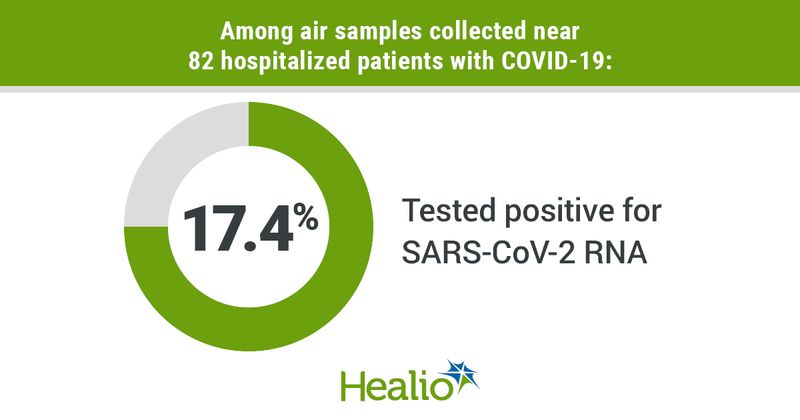Hospital air frequently contaminated with SARS-CoV-2, though viruses are rarely viable
Click Here to Manage Email Alerts
Around 17% of air samples taken close to patients hospitalized with COVID-19 were contaminated with SARS-CoV-2 RNA, although the viruses were rarely viable, according to findings from a systematic review published in JAMA Network Open.
“This confirms that the main transmission mode of SARS-CoV-2 seems to be through droplets and direct contact. Airborne transmission remains rare and opportunistic depending on the procedures performed on patients and the duration of exposure,” Gabriel Birgand, PharmD, MPH, PhD, of the National Institute for Health Research’s Health Protection Research Unit in Healthcare Associated Infections and Antimicrobial Resistance at Imperial College London, told Healio.

“For professionals, the surgical facemask works in most in-hospital circumstances. Respirators should be used for aerosol-generating procedures,” Birgand said.
The review uncovered the highest viral loads in the air of bathrooms, staff areas and public hallways, suggesting the need for “careful consideration of these areas for the prevention of COVID-19 transmission,” they wrote.

“However, the presence of viable viruses should be primarily considered, given that it is a required link for the potential of cross-transmission,” the authors wrote.
Birgand and colleagues reviewed 2,284 records regarding SARS-CoV-2 air contamination in hospitals from MEDLINE, Embase and Web of Science Databases. They described and compared SARS-CoV-2 viral RNA and culture positivity rates based on setting, air ventilation systems, clinical contexts and distance from patients.
The researchers found that 82 of 471 (17.4%) of air samples taken close to patients tested positive for SARS-CoV-2 RNA. Additionally, 27 of 107 (25.2%) of air samples close to patients in the ICU tested positive for SARS-CoV-2, compared with just 39 of 364 (10.7%) of air samples tested outside the ICU (P < .001). They also found that the virus positivity rate in air samples was 20 of 242 (8.3%) in clinical areas, 5 of 21 (23.8%) near toilets and 14 of 42 (33.3%) near public areas.
The review found that seven viral cultures (8.6%) from two studies were positive, “all from close patient environments,” Birgand and colleagues reported.
“Some misclassifications may have occurred when variables were categorized without enough detail. Moreover, the sampling and microbiology methods were highly heterogeneous across studies,” Birgand noted. “These flaws potentially affected the comparability of data and the reliability of pooled data analysis. For a better clarity of analysis, we did not include surface contamination. However, air and surface contamination are potentially correlated and may ease the understanding of resuspension.”
The researchers said the issue “requires more robust studies,” including a randomized clinical trial comparing surgical face masks with respirators to inform recommendations regarding respiratory protection for health care providers (HCP).
“Assessing SARS-CoV-2 RNA and viable virus contamination of surgical face masks and respirators worn by HCP according to a panel of procedures with patients with COVID-19 would provide information on exposure in routine practice,” they wrote.

